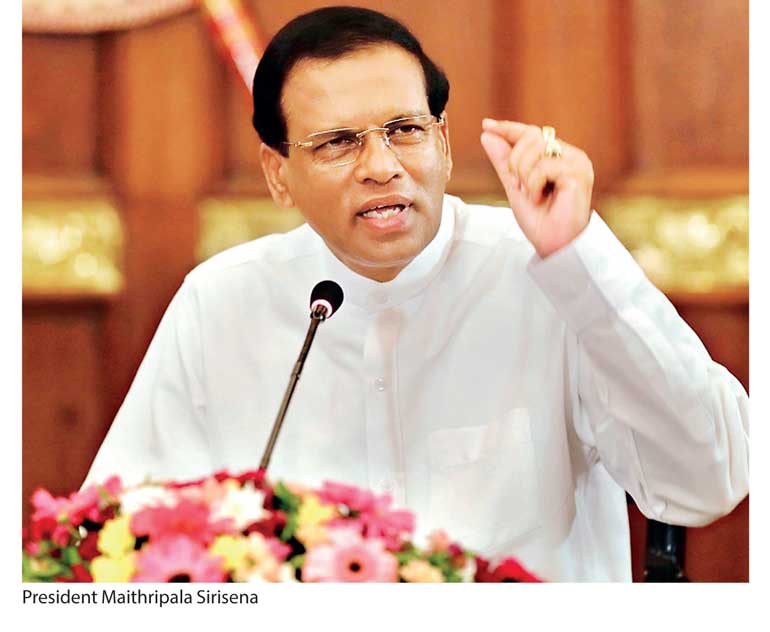Friday Dec 05, 2025
Friday Dec 05, 2025
Friday, 24 November 2017 00:00 - - {{hitsCtrl.values.hits}}

 “…A specialist brought down from the US Treasury, said Wickremesinghe, introduced the Government to this system. “We had to go ahead with macroeconomic liberalisation to get integrated into the global economy,” he said. Agreements with IMF and other documents were furnished by the Premier to the Commission to show the economic policy of the Government” – ‘Ranil resolute before Bond Commission,’ Daily FT, 21 November
“…A specialist brought down from the US Treasury, said Wickremesinghe, introduced the Government to this system. “We had to go ahead with macroeconomic liberalisation to get integrated into the global economy,” he said. Agreements with IMF and other documents were furnished by the Premier to the Commission to show the economic policy of the Government” – ‘Ranil resolute before Bond Commission,’ Daily FT, 21 November
Will the Local Government election prove to be the “great fall” of the Humpty-Dumpty coalition, or will all the Queen’s horses and all the Queen’s men be able to put Yahapalana Humpty together again?
And how many of the UNP’s Humpty-Dumpties will survive the stress-test of the local authorities’ election? Will the new, non-unitary Constitution project survive? Will the Budget, with its policy triad just described by Mangala at a Colombo University forum as “non-negotiable” i.e. “free enterprise, liberalisation and globalisation”? Will the commitment to implement the 2015 Geneva Resolution survive the electoral reality check?
The stakes for the official SLFP are even higher than for the UNP. In what shape will it survive an election? The SLFP (Official) is caught in a trap. If elections aren’t held in January, any social issue could trigger a riot. SAITM and the fuel shortage almost did. We stopped just short of the brink. Next time it might go over. So an election in January and no later, is a good thing.
When the UNP falls as it will in 2020, it will be to a Silent Revolution as in 1956 and 1970, but the morning after the election will not be silent, and will be at least as turbulent as in 1970 and 1977. Why should the UNP’s junior partner the SLFP face the same prospect? Why doesn’t it just get out from under; hit the ejector button right now?
But then again, surely the question is: why is any of this happening, and why is the prospect so bad for the SLFP faction backed by and backing the incumbent? What’s wrong with this picture?
The problem for the SLFP (O) is that it is about to pay for three political mortal sins.
One SLFP sin is being elected on anti-UNP votes in August 2015 and decamping to a UNP dominated Cabinet the morning after.
The official SLFP’s second sin is going along with the deprival of the bulk of the SLFP MPs elected in August 2015, of the formal post of Opposition, and the substitution in that role of a (minority) party with a minority of parliamentary seats.
The SLFP’s third sin is abandoning the Middle Path of moderate nationalism, allowing itself to be taken in a strategic policy direction, domestic and foreign, economic and political, that is unique to the Yahapalana ‘Gang of Four’ (Ranil-Chandrika-Mangala-Jayampathy) and way beyond the policy paradigm of the classic UNP, let alone the SLFP or a saddle-point between the two.
Testifying at the Presidential Commission into the Bond scam, Prime Minister Wickremesinghe was transparency personified as he disclosed how the economic policy of his Government was formulated and therefore how the economic and social destiny of our country and its citizens has been decided:
“…A specialist brought down from the US Treasury, said Wickremesinghe, introduced the Government to this system. “We had to go ahead with macroeconomic liberalisation to get integrated into the global economy,” he said. Agreements with IMF and other documents were furnished by the Premier to the Commission to show the economic policy of the Government”. (http://www.ft.lk/top-story/Ranil-resolute-before-Bond-Commission/26-643756)
The even-handed “curate’s egg” verdict by some ‘liberal-progressive’ Yahapalanista commentators on Mangala’s landmark Budget is vastly amusing, with its high marks for reconciliation, environment, women and youth, and low marks for taxes, poverty and inequality. Such eclecticism and empiricism eschew the category of ‘totality’ and holism in analysis, completely ignoring the logic of the political economy, the structural logic, of the neoliberal model manifested in Mangala’s Budget. On the heels of Dr. Sumanasiri Liyanage’s conceptually literate critique (‘Budget 2018 & the failure of Neoliberalism’), Prof Kumar David correctly notes in his latest article (‘Oligarchic Capitalism & Party-State structure’) that “the Government has made a sharp turn to economic neo-liberalism in the new Budget”.
Nowhere has “fast-tracking” “free enterprise, liberalisation and globalisation” as Mangala espouses and attempts to put into practice, succeeded in protecting the environment, youth and women and fostering reconciliation. Greater equity and less poverty are not apps that can be programmed into the neoliberal model. These are not options that the designers of the neoliberal model have absent-mindedly forgotten and need a gentle reminder to re-install. They are factors that are excluded from the model itself. Growing social inequity, exclusion and marginalisation structurally inhere in the model.
When even a Yahapalana intellectual such as Prof. Kumar David has noted the discontinuity (“sharp turn to economic neoliberalism”) that the Mangala Budget constitutes, it is disingenuous to equate Mangala’s and the Rajapaksas’ policy packages or place them on a continuum, with the worst possible epithet being that Mangala is almost as bad as Mahinda Rajapaksa! The Rajapaksa paradigm of statism, nationalism and ethno-populism, by its very logic, imposed certain parameters on the disposal of strategic national assets, and excessive privatisation was a deviation, not an aim and objective of the model and an inevitable result of the strategy.
By contrast, inherent in the very logic of unregulated free enterprise and the enthroning of “market principles” as Mangala calls it, is the growth of inequality and poverty, the ruin of the environment, and super-exploitation or marginalisation (or first one and then the other) of youth and women. The retrenchment of the State leads either to left-wing populism (if we are very lucky, and we aren’t), or ethno-religious nationalist populism of the radical Right, or downright anarchy.
The JRJ-Ronnie de Mel model of the Open Economy was itself vastly different from and infinitely superior to the current Ranil-Mangala model. The late Dr. Chanaka Amaratunga use to bemoan the fact that 60% of the economy remained in the hands of the state even under the UNP’s Open Economy-- a figure which JRJ used as argument to prove that his Constitutional retitling of Sri Lanka as a ‘Democratic Socialist Republic’ wasn’t simply evidence of his deadpan humour.
The most authoritative evidence of the sharp contradistinction between the JRJ and Ranil-Mangala models comes in a recent interview given by Pradip Jayewardene, who was very close to his grandfather. Making a damning indictment that “the core values of the UNP are eroding”, he emphasises that: “My grandfather was of the view that State control had to be maintained in the liberalisation process of the economy, to guarantee a social safety net…There is no argument that private sector should run business, but State control and regulation of key areas is vital…”
Right now “the chickens are coming home to roost” (as Malcolm X said), or are about to. The thing is that this is not inevitable. There are still a few moves and a window of opportunity in which to make them, if the official ‘moderate’ SLFP is not to be almost totally eclipsed by the populist-nationalist SLFP/JO.
The SLFP (official wing) is not led, managed and influenced solely by MS, as he shares influence with CBK, whose pro-UNP, anti-Mahinda stance is a huge political liability in the countryside and the SLFP ideological space. Her grip on reality and reason are so tentative that she thinks it credible and politically viable to remain a political partner of the UNP and its leader Ranil on whose watch the unprecedentedly colossal Central Bank bond scam took place, while loudly accusing the Rajapaksas of theft and opposing an SLFP rapprochement! She also thinks that her SLFP audiences would approve her attacks on Mahinda and lack of criticism of Ranil and the UNP.
President Sirisena needs to de-Chandrika-ise the SLFP; politically and ideologically purge it of CBK and her para-UNP influence. The official SLFP must become an SLFP-MS, no more an SLFP-MS-CBK. It is the official SLFP that stands to lose most from the destructive inner party and electoral influence of the cosmopolitan ‘Chandrikaist deviation’, unless mature leaders like Mahinda and Maithri are able to arrive at a “march separately, strike together” (Trotsky) pre-election pact of contesting separately but forming administrations together, post-election, at the local and provincial levels, which freeze out the UNP.
But can President Sirisena, who leads the country and the party, muster the political will and the support to make those moves? Does President Sirisena have ‘The Right Stuff’, or more accurately, the Center-Left stuff, to do likewise, and even more pertinently, to do so in the time frame that can make a difference?
The factor that may enable him to do this is the same as that which enabled Madam Bandaranaike and Mr. Premadasa to do so. He is, as they were, the leader of country, not only the party. It is by leveraging his role as the nationally elected Executive President and head of state (as Mrs. Bandaranaike was not, in 1964), that Mr. Sirisena can save his party or his faction of the party, from ignominy, marginality and near irrelevance if not near-oblivion.
The only way President Sirisena can conceivably change or slow the electoral chain reaction that starts with the Local Government elections is by changing the profile, discourse and strategic direction of the UNP in Government and of the Yahapalana Government as a whole. He has to shift to Yahapalana Mark II, a radically revised and re-engineered model, making the same drastic change that Premadasa made with, within and to the UNP government in 1988.
President Sirisena can give the UNP the alternative of staying in Government without Ranil-Mangala or staying with the latter duo while leaving the Government. If the UNP thinks it can outwit him by forming a government with the TNA, President Sirisena should let it, and send his wing of the SLFP into Opposition where it can launch a second front or be a claw of a pincer against the UNP-TNA bloc, shattering it at a referendum on a new Constitution and arriving at an arrangement with the JO as part of the inevitably winning coalition in 2020.
An SLFP (MS) presence in Opposition can also dilute the Sinhala Buddhist ultra-nationalism that is building up in and around the expanding anti-Government space.
A loyalist SLFP faction in the Opposition can be an investment for President Sirisena in any second term bid, giving him a chip to bargain with in negotiations with the JO which has no unambiguously obvious Presidential candidate—though Gota, Dinesh, Chamal and Basil are potential frontrunners.
President Sirisena could, if needs be, immediately and urgently split the UNP and unite its progressive liberals with his faction of the SLFP, while extending a generous invitation to the JO and MR, thereby creating a new, moderate-centrist political space, coopting or borrowing from both right and left, a la President Emmanuel Macron of France, while inclined to the centre-left.
The SLFP needs a game changer and its leader President Sirisena has to effect that game-changer or be that game-changer, before the year 2017 ends, because it may already be too late when New Year 2018 dawns. Tick-tock. Tick-tock.